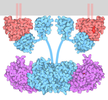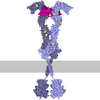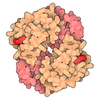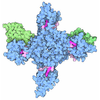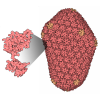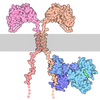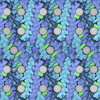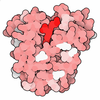+ データを開く
データを開く
- 基本情報
基本情報
| 登録情報 | データベース: PDB / ID: 9d9z | |||||||||
|---|---|---|---|---|---|---|---|---|---|---|
| タイトル | Structure of human UBR4-KCMF1-CaM E3 ligase complex (Silencing Factor of the Integrated stress response, SiFI) | |||||||||
 要素 要素 |
| |||||||||
 キーワード キーワード | LIGASE / E3 liase / UBR4 / SIFI | |||||||||
| 機能・相同性 |  機能・相同性情報 機能・相同性情報negative regulation of HRI-mediated signaling / synaptic signaling / ubiquitin-dependent protein catabolic process via the N-end rule pathway / protein K27-linked ubiquitination / cytoplasm protein quality control by the ubiquitin-proteasome system / protein branched polyubiquitination / negative regulation of fatty acid biosynthetic process / endosome organization / cytoplasm protein quality control / protein K11-linked ubiquitination ...negative regulation of HRI-mediated signaling / synaptic signaling / ubiquitin-dependent protein catabolic process via the N-end rule pathway / protein K27-linked ubiquitination / cytoplasm protein quality control by the ubiquitin-proteasome system / protein branched polyubiquitination / negative regulation of fatty acid biosynthetic process / endosome organization / cytoplasm protein quality control / protein K11-linked ubiquitination / CaM pathway / Cam-PDE 1 activation / Sodium/Calcium exchangers / Calmodulin induced events / positive regulation of ryanodine-sensitive calcium-release channel activity / Reduction of cytosolic Ca++ levels / Activation of Ca-permeable Kainate Receptor / CREB1 phosphorylation through the activation of CaMKII/CaMKK/CaMKIV cascasde / Loss of phosphorylation of MECP2 at T308 / CREB1 phosphorylation through the activation of Adenylate Cyclase / CaMK IV-mediated phosphorylation of CREB / PKA activation / negative regulation of high voltage-gated calcium channel activity / Glycogen breakdown (glycogenolysis) / CLEC7A (Dectin-1) induces NFAT activation / Activation of RAC1 downstream of NMDARs / organelle localization by membrane tethering / negative regulation of ryanodine-sensitive calcium-release channel activity / mitochondrion-endoplasmic reticulum membrane tethering / autophagosome membrane docking / negative regulation of calcium ion export across plasma membrane / regulation of cardiac muscle cell action potential / presynaptic endocytosis / Synthesis of IP3 and IP4 in the cytosol / regulation of cell communication by electrical coupling involved in cardiac conduction / Phase 0 - rapid depolarisation / calcineurin-mediated signaling / Negative regulation of NMDA receptor-mediated neuronal transmission / Unblocking of NMDA receptors, glutamate binding and activation / RHO GTPases activate PAKs / Ion transport by P-type ATPases / Uptake and function of anthrax toxins / regulation of ryanodine-sensitive calcium-release channel activity / tertiary granule membrane / ficolin-1-rich granule membrane / Long-term potentiation / protein phosphatase activator activity / Calcineurin activates NFAT / Regulation of MECP2 expression and activity / DARPP-32 events / protein K63-linked ubiquitination / catalytic complex / Smooth Muscle Contraction / detection of calcium ion / regulation of cardiac muscle contraction / RHO GTPases activate IQGAPs / regulation of cardiac muscle contraction by regulation of the release of sequestered calcium ion / protein K48-linked ubiquitination / calcium channel inhibitor activity / specific granule membrane / cellular response to interferon-beta / presynaptic cytosol / Protein methylation / Activation of AMPK downstream of NMDARs / Ion homeostasis / regulation of release of sequestered calcium ion into cytosol by sarcoplasmic reticulum / eNOS activation / titin binding / Tetrahydrobiopterin (BH4) synthesis, recycling, salvage and regulation / sperm midpiece / voltage-gated potassium channel complex / regulation of calcium-mediated signaling / calcium channel complex / positive regulation of autophagy / substantia nigra development / FCERI mediated Ca+2 mobilization / Ras activation upon Ca2+ influx through NMDA receptor / regulation of heart rate / FCGR3A-mediated IL10 synthesis / adenylate cyclase activator activity / calyx of Held / Antigen activates B Cell Receptor (BCR) leading to generation of second messengers / protein serine/threonine kinase activator activity / VEGFR2 mediated cell proliferation / sarcomere / regulation of cytokinesis / VEGFR2 mediated vascular permeability / Translocation of SLC2A4 (GLUT4) to the plasma membrane / spindle microtubule / positive regulation of receptor signaling pathway via JAK-STAT / RAF activation / Transcriptional activation of mitochondrial biogenesis / RING-type E3 ubiquitin transferase / Stimuli-sensing channels / cellular response to type II interferon / long-term synaptic potentiation / response to calcium ion / RAS processing / spindle pole / Signaling by RAF1 mutants 類似検索 - 分子機能 | |||||||||
| 生物種 |  Homo sapiens (ヒト) Homo sapiens (ヒト) | |||||||||
| 手法 | 電子顕微鏡法 / 単粒子再構成法 / クライオ電子顕微鏡法 / 解像度: 3.4 Å | |||||||||
 データ登録者 データ登録者 | Yang, Z. / Rape, M. | |||||||||
| 資金援助 |  米国, 2件 米国, 2件
| |||||||||
 引用 引用 |  ジャーナル: Nature / 年: 2025 ジャーナル: Nature / 年: 2025タイトル: Molecular basis of SIFI activity in the integrated stress response. 著者: Zhi Yang / Diane L Haakonsen / Michael Heider / Samuel R Witus / Alex Zelter / Tobias Beschauner / Michael J MacCoss / Michael Rapé /    要旨: Chronic stress response activation impairs cell survival and causes devastating degenerative diseases. Organisms accordingly deploy silencing factors, such as the E3 ubiquitin ligase silencing factor ...Chronic stress response activation impairs cell survival and causes devastating degenerative diseases. Organisms accordingly deploy silencing factors, such as the E3 ubiquitin ligase silencing factor of the integrated stress response (SIFI), to terminate stress response signalling and ensure cellular homeostasis. How a silencing factor can sense stress across cellular scales to elicit timely stress response inactivation is poorly understood. Here we combine cryo-electron microscopy analysis of endogenous SIFI with AlphaFold modelling and biochemical studies to report the structural and mechanistic basis of the silencing of the integrated stress response. SIFI detects both stress indicators and stress response components through flexible domains within an easily accessible scaffold, before building linkage-specific ubiquitin chains at separate, sterically restricted elongation modules. Ubiquitin handover by a ubiquitin-like domain couples versatile substrate modification to linkage-specific ubiquitin polymer formation. Stress response silencing therefore exploits a catalytic mechanism that is geared towards processing many diverse proteins and therefore allows a single enzyme to monitor and, if needed, modulate a complex cellular state. | |||||||||
| 履歴 |
|
- 構造の表示
構造の表示
| 構造ビューア | 分子:  Molmil Molmil Jmol/JSmol Jmol/JSmol |
|---|
- ダウンロードとリンク
ダウンロードとリンク
- ダウンロード
ダウンロード
| PDBx/mmCIF形式 |  9d9z.cif.gz 9d9z.cif.gz | 1.5 MB | 表示 |  PDBx/mmCIF形式 PDBx/mmCIF形式 |
|---|---|---|---|---|
| PDB形式 |  pdb9d9z.ent.gz pdb9d9z.ent.gz | 1.2 MB | 表示 |  PDB形式 PDB形式 |
| PDBx/mmJSON形式 |  9d9z.json.gz 9d9z.json.gz | ツリー表示 |  PDBx/mmJSON形式 PDBx/mmJSON形式 | |
| その他 |  その他のダウンロード その他のダウンロード |
-検証レポート
| 文書・要旨 |  9d9z_validation.pdf.gz 9d9z_validation.pdf.gz | 1.5 MB | 表示 |  wwPDB検証レポート wwPDB検証レポート |
|---|---|---|---|---|
| 文書・詳細版 |  9d9z_full_validation.pdf.gz 9d9z_full_validation.pdf.gz | 1.7 MB | 表示 | |
| XML形式データ |  9d9z_validation.xml.gz 9d9z_validation.xml.gz | 238.6 KB | 表示 | |
| CIF形式データ |  9d9z_validation.cif.gz 9d9z_validation.cif.gz | 373.6 KB | 表示 | |
| アーカイブディレクトリ |  https://data.pdbj.org/pub/pdb/validation_reports/d9/9d9z https://data.pdbj.org/pub/pdb/validation_reports/d9/9d9z ftp://data.pdbj.org/pub/pdb/validation_reports/d9/9d9z ftp://data.pdbj.org/pub/pdb/validation_reports/d9/9d9z | HTTPS FTP |
-関連構造データ
| 関連構造データ |  46686MC  9nwdC  9nweC C: 同じ文献を引用 ( M: このデータのモデリングに利用したマップデータ |
|---|---|
| 類似構造データ | 類似検索 - 機能・相同性  F&H 検索 F&H 検索 |
- リンク
リンク
- 集合体
集合体
| 登録構造単位 | 
|
|---|---|
| 1 |
|
- 要素
要素
| #1: タンパク質 | 分子量: 577180.938 Da / 分子数: 2 / 由来タイプ: 天然 / 詳細: (endogenously FLAG-tagged at the N-terminus) / 由来: (天然)  Homo sapiens (ヒト) / 細胞株: HEK293T / 参照: UniProt: Q5T4S7, RING-type E3 ubiquitin transferase Homo sapiens (ヒト) / 細胞株: HEK293T / 参照: UniProt: Q5T4S7, RING-type E3 ubiquitin transferase#2: タンパク質 | 分子量: 16852.545 Da / 分子数: 2 / 由来タイプ: 天然 / 由来: (天然)  Homo sapiens (ヒト) / 細胞株: HEK293T / 参照: UniProt: P0DP23 Homo sapiens (ヒト) / 細胞株: HEK293T / 参照: UniProt: P0DP23#3: タンパク質 | 分子量: 41992.348 Da / 分子数: 2 / 由来タイプ: 天然 / 由来: (天然)  Homo sapiens (ヒト) / 細胞株: HEK293T / 参照: UniProt: Q9P0J7, RING-type E3 ubiquitin transferase Homo sapiens (ヒト) / 細胞株: HEK293T / 参照: UniProt: Q9P0J7, RING-type E3 ubiquitin transferase#4: 化合物 | ChemComp-ZN / #5: 化合物 | ChemComp-CA / 研究の焦点であるリガンドがあるか | N | Has protein modification | Y | |
|---|
-実験情報
-実験
| 実験 | 手法: 電子顕微鏡法 |
|---|---|
| EM実験 | 試料の集合状態: PARTICLE / 3次元再構成法: 単粒子再構成法 |
- 試料調製
試料調製
| 構成要素 | 名称: Endogenous UBR4-KCMF1-CaM E3 Ligase complex (Silencing Factor of the Integrated stress response) タイプ: COMPLEX / Entity ID: #1-#3 / 由来: NATURAL |
|---|---|
| 分子量 | 値: 1.3 MDa / 実験値: YES |
| 由来(天然) | 生物種:  Homo sapiens (ヒト) Homo sapiens (ヒト) |
| 緩衝液 | pH: 7.5 |
| 試料 | 包埋: NO / シャドウイング: NO / 染色: NO / 凍結: YES |
| 試料支持 | グリッドの材料: GOLD / グリッドのタイプ: Quantifoil R1.2/1.3 |
| 急速凍結 | 装置: FEI VITROBOT MARK IV / 凍結剤: ETHANE / 湿度: 100 % / 凍結前の試料温度: 283.15 K |
- 電子顕微鏡撮影
電子顕微鏡撮影
| 実験機器 |  モデル: Titan Krios / 画像提供: FEI Company |
|---|---|
| 顕微鏡 | モデル: TFS KRIOS |
| 電子銃 | 電子線源:  FIELD EMISSION GUN / 加速電圧: 300 kV / 照射モード: FLOOD BEAM FIELD EMISSION GUN / 加速電圧: 300 kV / 照射モード: FLOOD BEAM |
| 電子レンズ | モード: BRIGHT FIELD / 最大 デフォーカス(公称値): 2600 nm / 最小 デフォーカス(公称値): 800 nm / Cs: 2.7 mm |
| 撮影 | 電子線照射量: 40 e/Å2 フィルム・検出器のモデル: GATAN K3 BIOQUANTUM (6k x 4k) |
- 解析
解析
| EMソフトウェア |
| ||||||||||||||||||||||||||||||||||||||||||||
|---|---|---|---|---|---|---|---|---|---|---|---|---|---|---|---|---|---|---|---|---|---|---|---|---|---|---|---|---|---|---|---|---|---|---|---|---|---|---|---|---|---|---|---|---|---|
| CTF補正 | タイプ: PHASE FLIPPING ONLY | ||||||||||||||||||||||||||||||||||||||||||||
| 3次元再構成 | 解像度: 3.4 Å / 解像度の算出法: FSC 0.143 CUT-OFF / 粒子像の数: 126380 / 対称性のタイプ: POINT |
 ムービー
ムービー コントローラー
コントローラー






 PDBj
PDBj









